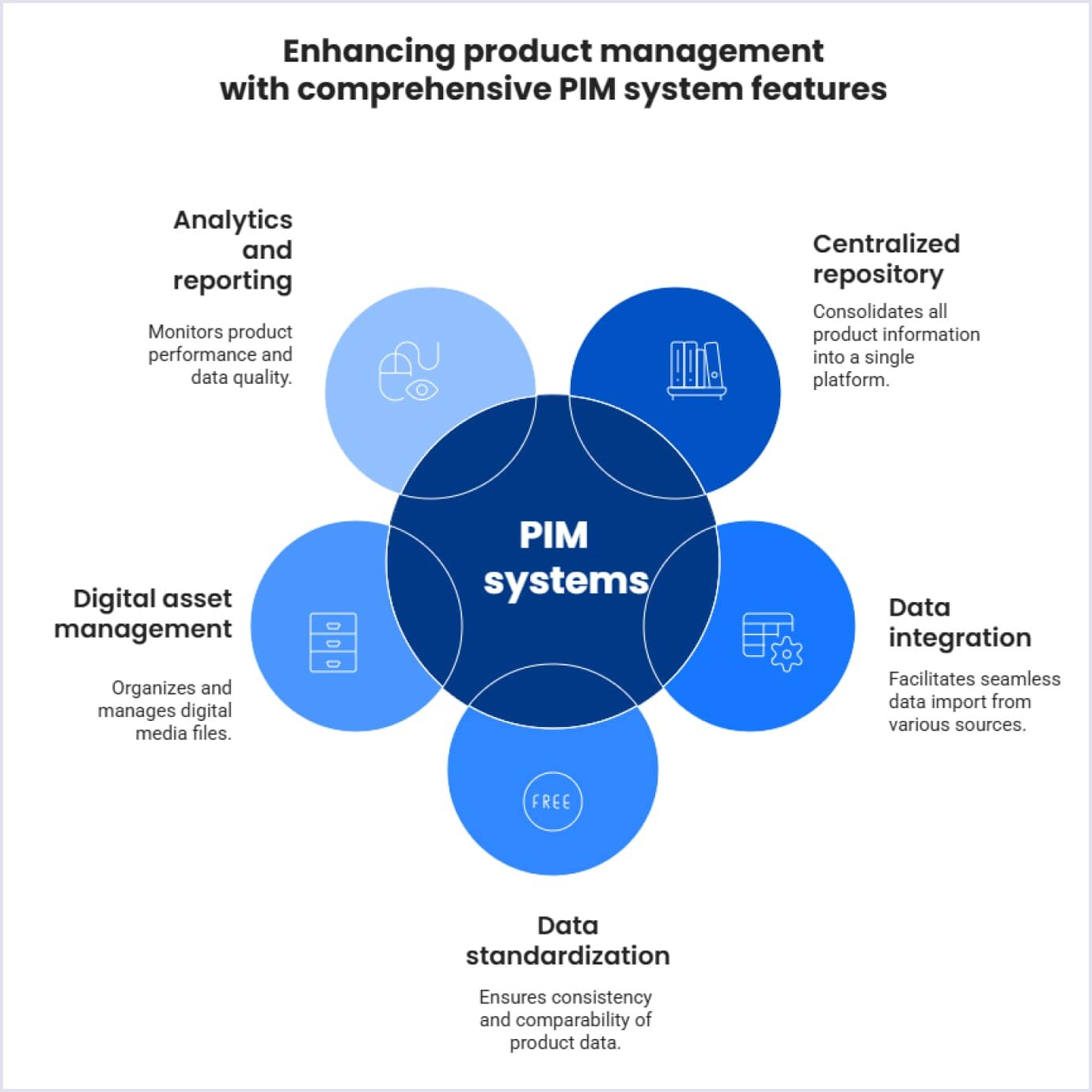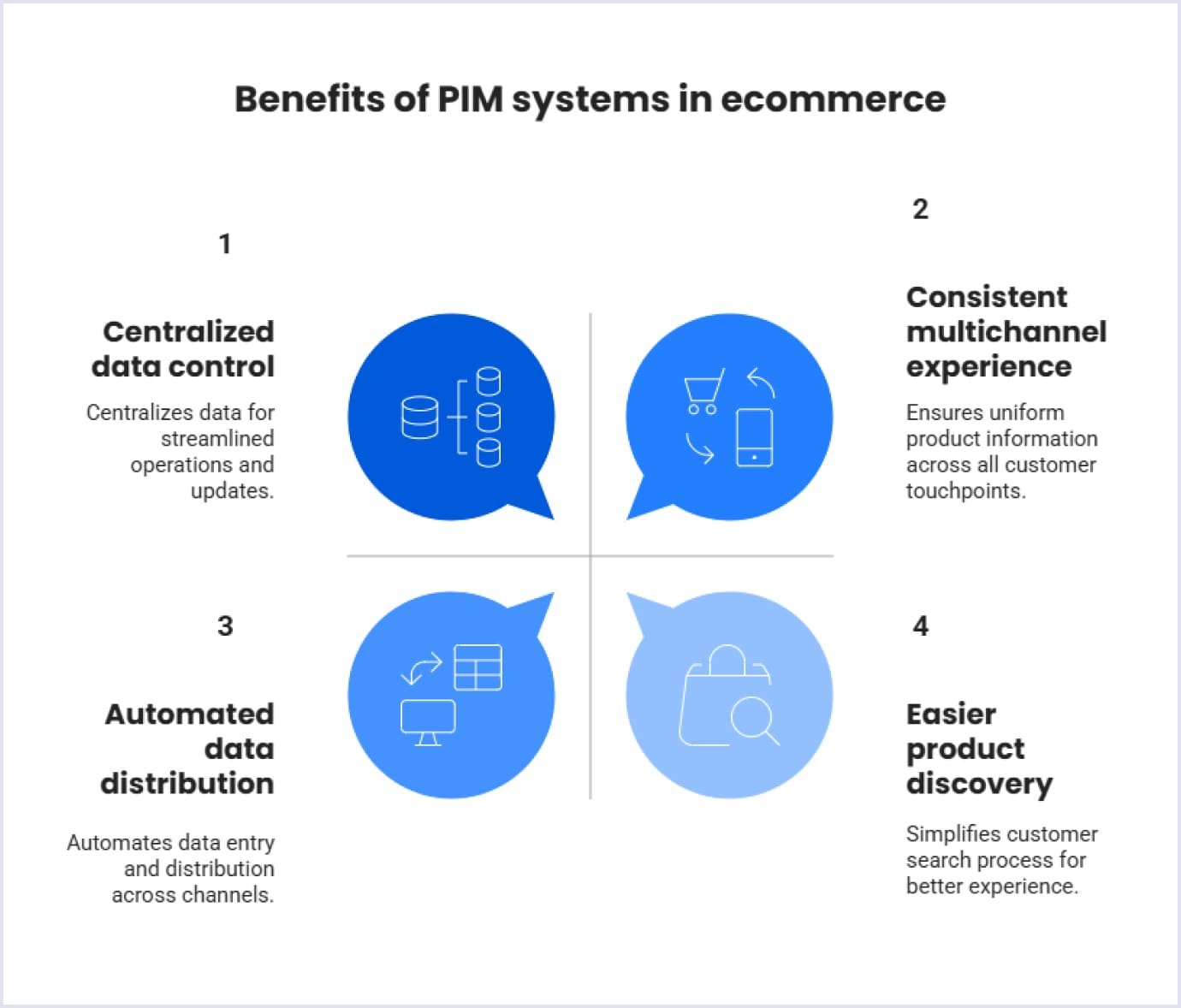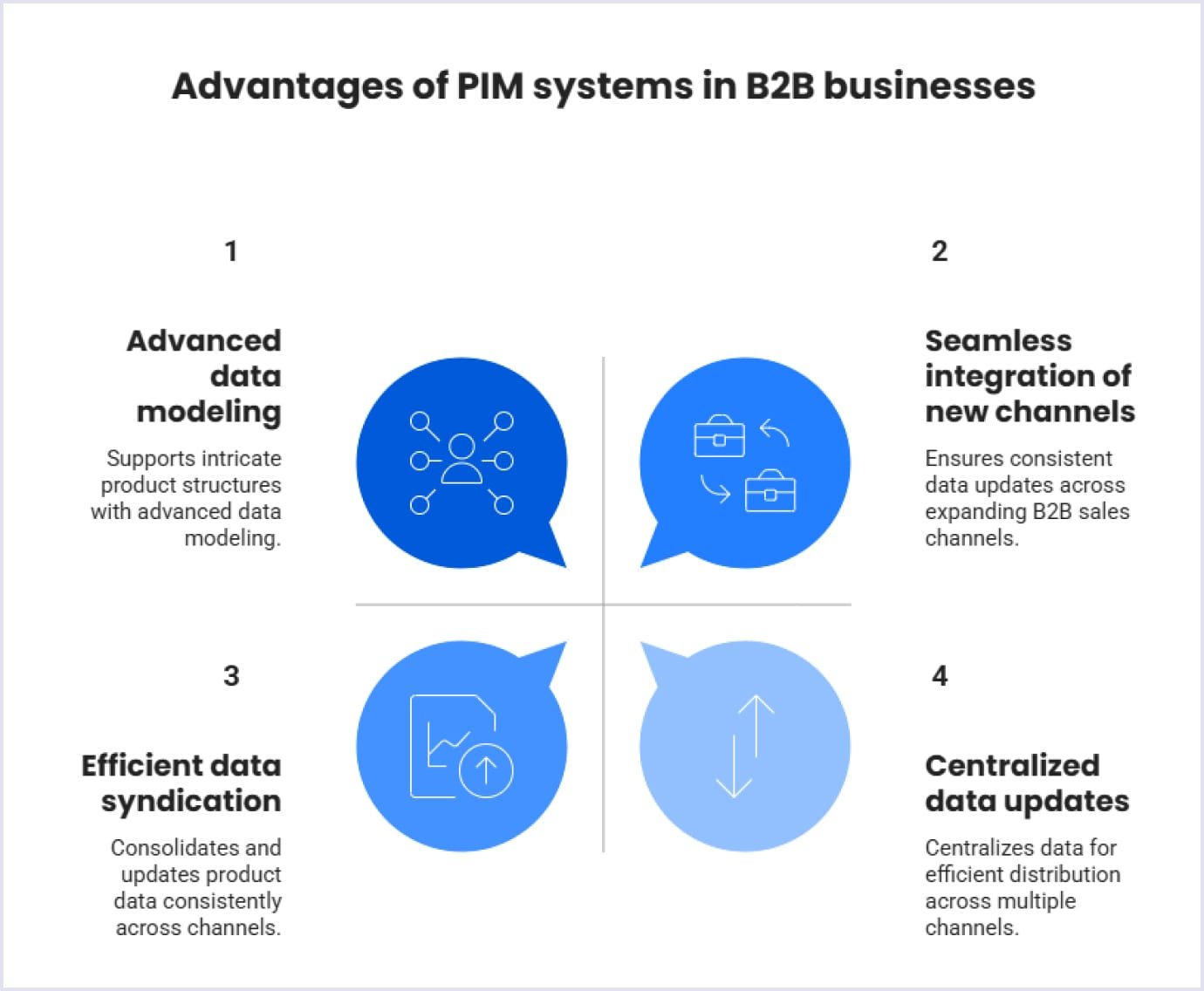When it comes to managing extensive data across various sales channels, PIM (Product Information Management) systems come in handy. Not only do they help to make data consistent, but the systems also provide quick updates to various touchpoints. This ensures that your team, partners, and customers receive consistent and accurate product data. PIM systems help to manage complex product catalogs, multichannel commerce, global expansion, and changing customer demands.
In this beginner’s guide from our experts, we outline the benefits of a PIM system, its features, and steps to implement. We also cover prominent examples of PIM systems and how they help businesses to streamline complex product data management. Read on to learn how you can streamline your sales with a PIM solution.
Overview of Product Information Management (PIM) systems
Organizing data with PIM systems is a go-to solution for ecommerce and B2B businesses. In fact, the lucrative market of PIM platforms is expected to reach $23.8 billion by 2027, with the CAGR (compound annual growth rate) for this niche at 14.3%.
Given that today’s ecommerce and B2B businesses use multiple channels and sources to manage their product data, it is paramount to have a single system that organizes extensive information. With a PIM solution, you can collect, manage, and distribute product data across all sales and marketing channels.
Whether you deal with large product catalogs, multiple stock-keeping units (SKUs), or sell across regions and languages, a PIM system simplifies product content management. It ensures that specifications, pricing, images, translations, localizations, and documentation remain consistent across different digital touchpoints. As a result, you streamline your operations and improve customer experience across your sales channels.
Understanding the basics of PIM systems
What is a PIM system?
A Product Information Management (PIM) system is a centralized software solution that helps you manage your product and sales data across different channels and localizations. It keeps your product-related content consistent, including names, descriptions, technical specifications, images, pricing, SKU information, and compliance data.
With user-friendly PIM systems, you do not have to input the necessary information repeatedly. Once you’ve made updates in the PIM interface, they reach all your websites, marketplaces, print catalogs, mobile apps, and internal systems like ERP or CRM.
Also, PIM is a connecting point that allows you to pass your product content to all involved in your sales. They might include your internal team, suppliers, manufacturers, wholesalers, and customers.
Key features of PIM systems
PIM platforms are designed to provide you with helpful features for your product management consistency. The main features of PIM solutions include the following:

- Centralized product data repository. Consolidates all product information into one centralized platform. The data might include descriptions, specifications, pricing, images, and more.
- Data importation and integration. Facilitates seamless data import from various sources. These include ERP systems, spreadsheets, and supplier databases.
- Data standardization and classification. Standardizes and classifies product data and ensures consistency across all channels. This feature makes it easier for customers to find and compare products.
- Bulk editing and automation. Allows users to manage large volumes of product data, reduces manual efforts, and minimizes errors.
- Channel-specific data management. Customizes product information for different sales channels. As a result, each channel receives data in the proper format and meets specific requirements.
- Digital asset management. Manages digital assets associated with products, including images, videos, and documents. The feature ensures that media files are organized and easily accessible.
- Workflow management and collaboration. Supports collaboration across teams and streamlines workflow management.
- Localization and translation management. Multilingual support enables you to manage localization and translation of product information. The feature ensures consistency and cultural relevance across markets.
- Quality control and data governance. These features help you comply with data governance policies. As a result, you maintain data accuracy and compliance with industry regulations.
- Analytics and reporting. Enable you to monitor product performance, data quality, and process efficiency.
Read also: The Importance of Real-Time Inventory Sync in Auto Parts Marketplaces
Top PIM platforms in the market
Akeneo
The Akneo system provides data enrichment tools, streamlines omnichannel management, and helps businesses adapt to changing market dynamics. It serves companies, individual retailers, and distributors. The solution cuts time-to-market, doubles online orders, and reduces employee workload.
Inriver
This platform allows you to process raw data, enrich data with AI-generated product information, distribute data across various channels, and evaluate and optimize product performance. Inriver brings tangible results, such as 99% time-to-market reduction, 28% online visibility growth, and 8x faster information delivery to customers.
Jasper PIM
It is a single data repository that serves ecommerce merchants. The Jasper PIM solution supports multiple languages and currencies across different sales channels. The platform also integrates with Shopify and BigCommerce to provide more flexibility to users.
Salsify
This cloud solution has an extensive feature set that supports all needs around product management. Salsify ensures that you manage product data from one source, enrich product information with media, synchronize data content across consumer touchpoints, and more.
UnoPim
It is open-source software that helps you manage your data from ERP, suppliers, media, and marketing. This data is distributed to your ecommerce store, retail POS, marketplaces, and mobile apps. UnoPim is free, easy to use, and customizable.
Importance of PIM systems in ecommerce
Enhancing customer experience
With high customer demand and competition, ecommerce marketplace solutions need efficient management of sales. Inconsistencies in product descriptions can lead to returns and poor reviews. That is why consistency is vital to making your brand appealing and trustworthy. Here's how PIM systems in ecommerce make a shopping path satisfying and efficient:
- Easier product discovery. Robust product categorization and tagging with a PIM solution simplifies the search process for customers. Thanks to well-organized categories and advanced functionalities, customers quickly find what they want.
- Enhanced product information. As product data are centralized in PIM, sellers can enrich their product descriptions with media. It boosts search engine visibility and customer engagement.
- Consistency across the channels. PIM’s data centralization allows you to keep it the same when passed to different touchpoints of ecommerce solutions. This consistency helps shoppers find the necessary products on your website, via your mobile app, or in your physical store.
Streamlining operations
As a unified system, PIM provides a place where your team can collaborate and input the necessary product data. As a result, PIM systems facilitate quicker product launches and updates. Here is how you can achieve this:
- Centralized data management. A PIM platform acts as a single data repository. Changes in the system will appear on all platforms thanks to product data centralization. With this feature in place, your team maintains updates, reduces errors, and saves time.
- Reduced data entry with automation. As product data collection and distribution is automated in PIM, your team spends less on manual input. As a result, the system preserves your data integrity.
- Efficient multichannel integration. Integrating various sales channels, thanks to the PIM system, makes information uniform and synchronized. Thus, you get simplified listing management and streamlined operations.

The essential role of PIM systems in B2B businesses
Managing complex product data
B2B companies manage product data that might have important specifications, meet regulations, and must be processed securely. PIM solutions help organize these complex data and automate tedious processes in sales operations. Here is what B2B companies gain with a PIM platform:
- Consistent data entry. A PIM system consolidates complex product data, such as specifications, pricing, and digital assets. The data updates consistently across channels and stakeholders.
- Advanced data modeling. B2B products often involve intricate relationships, such as bundles, kits, and configurable options. PIM supports advanced data modeling. Thus, they help manage and accommodate various product structures and relationships.
- Efficient data syndication. Thanks to centralized B2B product management, PIM sends updates automatically across channels and stakeholders. These updated data appear across partner platforms and eliminate the need for manual updates.
- Enhanced data quality and governance. Automatic data management in PIM eliminates inaccuracies and provides error-free product data. As the data updates consistently, your team saves time and effort in entering the new information.
Facilitating omnichannel distribution
When managing B2B sales, there are several distribution channels. They include digital touchpoints, such as websites, mobile apps, marketplaces, and physical channels, which are physical stores, points of sale, and third-party distributors.
- Centralized data updates and management. A PIM system’s data centralization and updates allow you to deliver the necessary information across different channels.
- Seamless integration of new channels. As your B2B sales expand, adding new channels to your PIM solution ensures that the data updates are consistent. Thus, your third-party contractors and customers get the necessary information.
- Streamlined data accommodation. As your B2B business expands to new markets, PIM adjusts measurements, currencies, and translations, saving you effort and resources.

Benefits of implementing a PIM system
Improved data accuracy
PIM provides a unified platform for data entry and updates, ensuring consistency across channels. Thanks to the system, when you need to enter a new product description or media, you get it across your various channels. As a result, the updated product information helps you with the following processes:
- Proper inventory management. With the PIM solution in place, you control optimized stock levels and plan and forecast replenishments.
- Correct order fulfillment. As product information is up-to-date, you prevent back orders and incorrect orders resulting in returns and refunds.
- Uniform data for third-party contractors. Thanks to PIM, the business passes the necessary updates to sellers and suppliers, which improves the workflow and strengthens the partnerships.
You may also like: Top 11 Integrations Every Marketplace Needs
Enhanced collaboration
With PIM, you can automate data entry through a single source. As a result, teams gain centralized and streamlined management of product data. See how the PIM system streamlines workflow for teams:
- Real-time data updates. With PIM, updates are accessible for the teams across different departments and locations, which prevents data silos. These updates improve decision-making, communication, and coordination among different departments.
- Clear roles and responsibilities. The product information management process enhanced with the PIM platform enables you to define roles and responsibilities. Clear role definitions boost workflow efficiency by helping team members understand their responsibilities.
- Prevention of duplication. Thanks to the single source, teams no longer need to input the same information multiple times. The updates appear and become available to others once they are entered.
- Improved external collaboration. Using PIM streamlines the exchange of product information with third-party retailers and suppliers. The shared data is accurate and provided in proper formats.

Selecting the right PIM system for your business
When choosing PIM for your business, several factors should be considered. They include how the PIM solution serves your business goals and how it fits your existing infrastructure and scalability needs. Here are the crucial aspects to consider when selecting the PIM platform:
- Understand your objectives for implementing a PIM system;
- Evaluate the features you need in the system for your business goals;
- Consider if the system is customizable and scalable;
- Assess the system’s integration capabilities regarding your existing software;
- Ensure that your PIM vendor provides the necessary tech support in case of a possible disruption in operations;
- Analyze if the pricing aligns with your return on investment (ROI) goals;
- Explore free trials and demos before making your decision.
Steps to implement a PIM system
Planning and strategy
Implementing a PIM system is a multi-step process that requires a strategic approach. It encompasses planning, data assessment, and key performance indicator (KPI) measurement. Consider the following steps to plan your PIM implementation:
- Define your objectives. These are the goals you want to achieve with the PIM solution. They might include enhancing data quality, increasing operational efficiency, reducing costs, and accelerating time-to-market. The outlined goals will guide the implementation process and help you assess its success.
- Conduct a comprehensive data audit. Assess your current product information for accuracy, completeness, and consistency. Identify your data sources, such as ERP system, spreadsheets, and databases. With this assessment, you will understand how to migrate your data.
- Develop a detailed project plan. Your comprehensive project plan should outline the scope, timeline, resources, and milestones for the PIM implementation. It will help you prevent project creep and help all involved to be on the same page throughout the process.
- Design a data migration strategy. Plan the migration of your existing product data into the new PIM system. This involves mapping data fields, transforming data formats if necessary, and establishing protocols for data validation and cleansing. This helps ensure data integrity during the transition.
- Assemble a team. Creating and maintaining data involves different roles, including IT, marketing, sales, and product management. When planning the implementation of PIM, assign specific roles so that the work of your team is efficient.
Further reading: What Is Project Discovery Phase in Custom Software Development
Integration and training
These two steps ensure that your PIM fits your existing software and brings the business benefits.
PIM integration involves the following steps:
- Outlining how the PIM system will interface with existing platforms such as ERP, CRM, and ecommerce solutions. Define data flow processes and synchronization schedules to ensure clarity and consistency.
- Using application programming interfaces (APIs) to facilitate real-time data exchange between the PIM solution and other software applications. APIs enable efficient and secure communication, ensuring data consistency across platforms.
- Implementing data validation protocols to maintain data accuracy during integration. These automated checks help you prevent erroneous data entries.
- Perform pilot testing before full-scale integration. It assists you in spotting the needed adjustments before the actual rollout.
The training on the PIM system should be customized to different roles. Use role-specific training modules and tailored training materials. Check what works best for your staff: workshops, webinars, or hands-on sessions. Also, maintaining the documentation and support system will help your team to better understand the PIM platform and use it to the best of your business goals.

On a closing note
PIM systems are essential solutions in product information management. With them, instead of tedious and error-prone processes, you get consistent updates across your sales channels. This enhancement not only boosts your sales but also improves the workflow for your teams and strengthens relationships with your third-party contractors.
If you need a smooth implementation of a PIM solution in your existing software, our team is eager to help you. With years of experience in custom software development services and dozens of successful projects, our professionals will build and customize it for your specific business needs.
Check out our portfolio and feel free to contact us to discuss the details.
